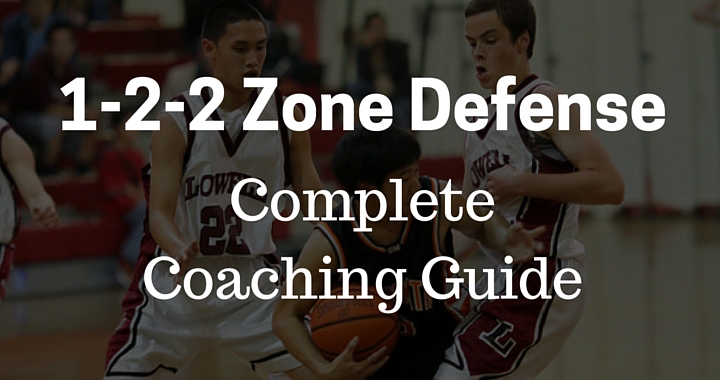 The 1-2-2 zone defense is a variation of the more commonly used 2-3 zone.
The 1-2-2 zone defense is a variation of the more commonly used 2-3 zone.
The main difference is that the 1-2-2 zone defense is a great defense against teams that score a majority of their points from the perimeter, whereas the 2-3 zone provides more inside presence.
This is because, in the 1-2-2- zone, all 5 defenders have a responsibility to guard an area on the perimeter.
This allows quick closeouts and the ability to contest every shot taken from the three-point line.
Therefore, the 1-2-2 zone defense is often used against teams that have strong guards and three-point shooters but aren’t strong on the inside.
Strengths
The three biggest strengths of the 1-2-2 zone defense are:
1. Defending Shooters – The 1-2-2 zone defense is better at defending against the three-point shot that the 2-3 zone is.
2. Fast Break – With the top player in the middle and two wings, the players are in great positions to transition into the fast break if there is a turnover. Put your point guard on a wing and put a long, athletic player that can finish at the top.
3. Trapping Opportunities – There are great trapping opportunities out of the 1-2-2 zone defense — especially in the corner.
Weaknesses
The three biggest weaknesses of the 1-2-2 zone defense are:
1. Rebounding – Since no players have their own player they’re on, everyone must find a player to box out when there’s a shot.
2. The High Post – The opposition getting the basketball into the high post is what hurts a 1-2-2 zone defense the most. A good passing team that manages to get the basketball there often can pick your team apart.
3. Post Players Must Guard Corners – This can be a problem if you have post players that don’t move quickly, or if you only have a couple of big players that you’d prefer to leave inside the key.
1-2-2 Zone Defense Rules:
1. Hands Up at All Times – Teams must keep the basketball out of the paint and the high post. That’s where this defense is most vulnerable.
2. Move on Air Time of the Pass – If players don’t move on the air time of the pass, they’re going to get to their assignment too late which will allow the offensive player to take an uncontested shot or get in the lane and create for their teammates.
3. Prevent Inside Passes – When running the 1-2-2, we do not deny perimeter passes. Instead, all defenders sag back and prevent the inside pass (similar to the Pack Line defense).
4. Rebound – As with all zones, on each shot attempt, every player must find someone to box out and then go after the rebound.
5. Post Players Must Front the Post – In order to get out to the shooters in the corners quickly, all bigs must be fronting the post when the basketball is on their side of the court.
The Difference Between the 1-2-2 Zone and the 3-2 Zone
Since this question gets asked often and there’s a lot of confusion around the answer, I wanted to address it before we get into the core of this article.
The main difference between the 1-2-2 zone defense and the 3-2 zone is how the top defender plays when the basketball is at the top of the key.
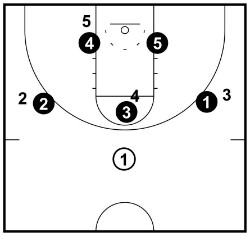 In a 1-2-2 zone defense, the top defender is on the basketball and the two wings are protecting the free-throw line and allowing the pass to be made to the wing.
In a 1-2-2 zone defense, the top defender is on the basketball and the two wings are protecting the free-throw line and allowing the pass to be made to the wing.
In a 3-2 zone, the top defender doesn’t pressure the point guard. Instead, they sag back and deny the pass into the high post. (Obviously, this can only be done against a team that can’t shoot from the outside.)
By denying the high post with the top defender, the wing defenders can deny the pass around the perimeter.
Roles and Responsibilities
Top Defender
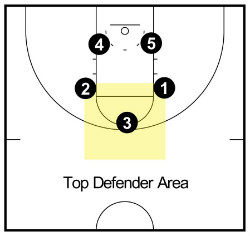 The top defender must be athletic and smart. This player is usually the key to how successful your 1-2-2 will be.
The top defender must be athletic and smart. This player is usually the key to how successful your 1-2-2 will be.
They have two main responsibilities…
1. When the basketball is at the top of the key and advancing over half-way, they should be guiding the offensive player to one side of the court.
2. When the basketball is anywhere else on the court, the top player must deny the basketball getting into the high post since this is the weakest area of the zone.
Wing Defenders
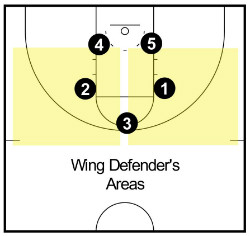 The wing defenders first responsibility is to protect the high post when the basketball is at the top of the key.
The wing defenders first responsibility is to protect the high post when the basketball is at the top of the key.
When the basketball is on their wing, the wing defender guards the basketball. And when the basketball is in the corner, the wing defender can either trap, deny the reverse pass, or sag into the lane.
Post Defenders
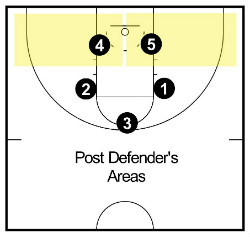 The post defenders main role is to protect the paint, guard the low-block, and rebound.
The post defenders main role is to protect the paint, guard the low-block, and rebound.
What makes this defense different from most others is that they’re also required to defend the basketball when it’s in the corners.
This requires the post defenders to be able to play both front the post player, and also defend them from behind.
How to Run the 1-2-2 Zone Defense
Basketball Top of the Key
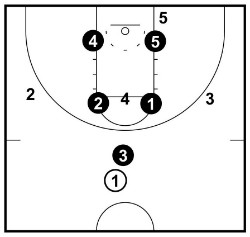 When the basketball being dribbled over half-court it’s the top defender’s responsibility to pick them up.
When the basketball being dribbled over half-court it’s the top defender’s responsibility to pick them up.
The top defender shouldn’t do this immediately as they cross because it makes it too easy for the offense to make a quick pass to the wing and then into the high post, they should pick them up when they’re about 2 – 3 meters from the three-point line.
When the top defender is pressuring the basketball at the top, the wings must pinch in to the high post and protect the opposition making a pass inside.
This means we don’t put any pressure on the pass from the top to the wing.
In fact, we want the opposition to make this pass. But the wing defenders must be ready to immediately close out to the wing players on the flight of the basketball.
The two post defenders must have a foot inside the key when the basketball is at the top. This way we have presence on the inside but can also close out to the corners if a pass is made there.
Basketball on the Wing
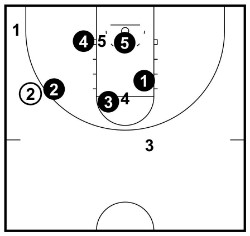 When the basketball is passed to the wing, the wing player on the strong-side must immediately close out on the ball to prevent the open shot.
When the basketball is passed to the wing, the wing player on the strong-side must immediately close out on the ball to prevent the open shot.
As this happens, the top defender must drop to the high post and get into denial position.
The weak-side wing player drops down a couple of steps and has one foot in the key. This gives them the opportunity to pick off any skip passes that may be thrown and also provide help inside.
The strong-side post player must get front position on the low post. If the post player is stuck behind, they won’t be able to defend the pass to the corner.
And the weak-side post player should be playing split line in the middle of the key. They must be ready for the lob pass to be thrown over the other post player that’s fronting their player.
Basketball in the Corner
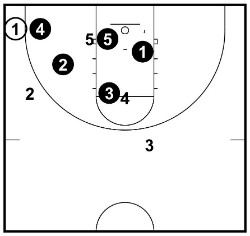 When the basketball is passed to the corner it’s the strong-side low post player’s responsibility to close out on the basketball.
When the basketball is passed to the corner it’s the strong-side low post player’s responsibility to close out on the basketball.
They must do this by closing out with high hands and taking away the baseline. If the offensive player drives we want them driving into the middle of our zone.
The top defender continues to deny the pass into the high post.
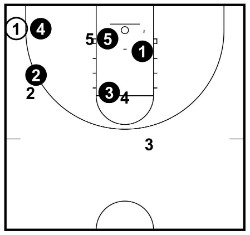 The weak-side low post must now slide across and defend the strong-side low block if there’s an offensive player there but doesn’t front.
The weak-side low post must now slide across and defend the strong-side low block if there’s an offensive player there but doesn’t front.
The weak-side wing player drops down and plays the split line.
The strong-side wing player has 3 options…
1. Sag in and prevent the inside pass – By dropping into this space, you’ll prevent a pass inside the key to cutters. This option allows the opposition to pass the ball back out to the wing.
2. Hard deny the wing – By denying the pass back out of the corner, it puts a lot of pressure on the player in the corner to make a good pass. The only drawback to this is that we leave a big gap that cutters can get to and get open shots.
3. Trap the corner – I will elaborate further on this in the next section. But keep it in mind!
Basketball in the High Post
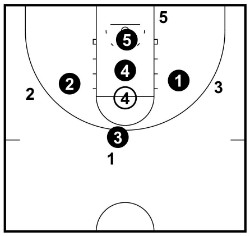 The high post is the weakest area in a 1-2-2 zone defense. So it’s super important that your team knows how to defend when the basketball is there.
The high post is the weakest area in a 1-2-2 zone defense. So it’s super important that your team knows how to defend when the basketball is there.
When the basketball gets to the high post you must bring one of your big men up to guard them. I like to designate this person from the start of the game so the players always know. For this article we’ll say the 4 must come up and defend while the 5 stays back to protect the key.
When the basketball is passed into the high post, 4 immediately comes up and defends the the basketball while 5 slides to the middle of the key with their arms out wide to protect from passes inside.
The top defender can dig at the basketball to get the high post player to pass it out to the top but the wing defenders must not pinch in.
The wing defenders must stick to the players on the wings because we don’t want to give up an open three-point shot.
When the basketball is in the high post it turns into ‘pick your poison’ and we’d much rather an opponent shoot a long two-point shot over an outstretched arm of our post player than to give away a wide open three-point shot.
Basketball in the Low Post
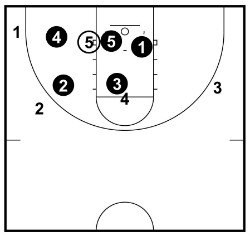 Since we front the low-post at all times, there won’t be many opportunities for the offense to get a low-post post up.
Since we front the low-post at all times, there won’t be many opportunities for the offense to get a low-post post up.
If they do get the basketball inside, it will most likely come off a pass from the corner since that’s the only time the low post won’t be fronted by a defender.
When this happens, the low post strong-side player should dig at the basketball while staying close enough to the corner to not allow an open shot, and the low-post weak-side player is tasked with defending the basketball.
The weak-side wing drops down and covers the key while being ready for the skip pass, the strong-side wing denies the pass back out to the wing player, and the top defender is still denying the pass to the high post.
Trapping Options
In a few moments, I’ll explain to you the two traps that work well with the 1-2-2 zone defense.
As with most zones, the best traps are the ones performed in the corners of the court. This is because the sideline and baseline act as extra defenders and limit the passing options of the offense even further.
Because of this, I always trap the corners and recommend you do too if your players are experienced enough.
The trap on the wing should be used as a surprise to the offense on rare occasions. For example, it could be used nearing the end of a close game when your team desperately needs a steal.
Trapping at the Top
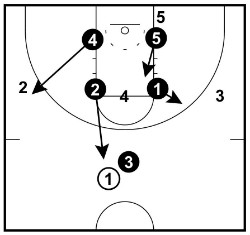 Trapping at the top of they key can be used if you need a quick interception opportunity.
Trapping at the top of they key can be used if you need a quick interception opportunity.
It begins with the top defender directing the dribbler to one side of the court as they dribble across the half-way line.
On a signal, the strong-side wing sprints up and the top defender and wing defender set a trap on the ball-handler.
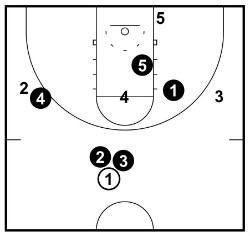 At the exact same time, the strong side low post must sprint high and take away the easy pass the dribbler can make to the wing since this will be the dribblers first pass opportunity.
At the exact same time, the strong side low post must sprint high and take away the easy pass the dribbler can make to the wing since this will be the dribblers first pass opportunity.
It’s now up to the trappers to get a deflection and the other two defenders to read the pass and intercept a pass to one of the other three offensive players on the floor.
This is a great trap if you need a quick steal late in the game.
Trapping on the Wing
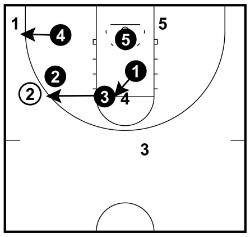 This trap can be performed any time the basketball is on a wing, but I find it works best directly after the basketball has been reversed out of the corner.
This trap can be performed any time the basketball is on a wing, but I find it works best directly after the basketball has been reversed out of the corner.
If you want this trap to be effective, you must catch the offense by surprise.
As it’s being passed out, the strong-side wing and the top defender immediately sprint at the basketball and set a double team.
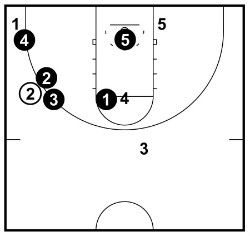 The strong-side post player gets up in the lane to cut off the pass to the corner player, the weak-side post player stays on split line, and then the weak-side wing player must try and read the eyes of the passer and intercept the pass to one of the two other offensive players on the court.
The strong-side post player gets up in the lane to cut off the pass to the corner player, the weak-side post player stays on split line, and then the weak-side wing player must try and read the eyes of the passer and intercept the pass to one of the two other offensive players on the court.
Similar to the trap at the top, this is a great trap if you need a quick steal but shouldn’t be used more than a couple of times each game.
Trapping the Corner
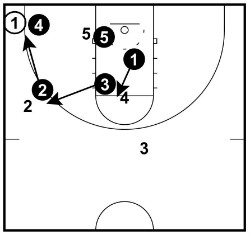 The corner is the best place on the court to trap the basketball.
The corner is the best place on the court to trap the basketball.
This is because you get the added benefit of the offensive player being restricted by the baseline and sideline, too.
When the basketball is passed from the wing to the corner, both the strong-side post and strong-side wing players close out to the basketball with high hands remembering to avoid fouling.
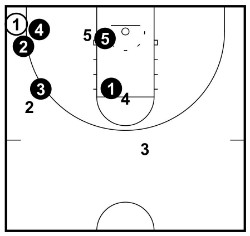 As this happens, the top defender slides across to deny the pass back out, the weak-side post player anticipates and then half-fronts a player on the strong-side low post if there is one, and the weak-side wing must then attempt to get a deflection or steal from one of the other two players on the court.
As this happens, the top defender slides across to deny the pass back out, the weak-side post player anticipates and then half-fronts a player on the strong-side low post if there is one, and the weak-side wing must then attempt to get a deflection or steal from one of the other two players on the court.
This is the best trap out of the 1-2-2 and I recommend that you use it often once your players understand it.
Defending Skip Passes
Defending skip passes in the 1-2-2 zone defense is reasonably simple since we use all 5 players as perimeter defenders.
Let’s go over the three main skip passes and how to defend them in the 1-2-2 zone defense.
Wing to Corner Skip Pass
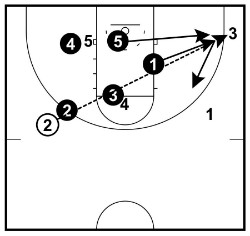 If the basketball is skipped from the wing to the corner, the weak-side wing must close out on the high side of the corner player so that there’s not a quick reversal pass.
If the basketball is skipped from the wing to the corner, the weak-side wing must close out on the high side of the corner player so that there’s not a quick reversal pass.
They only hold this position for a second or two as they should be immediately bumped up by the post player who should be spriting from defending the opposite post to covering the corner.
Depending on how aggressive you want to play the 1-2-2, this can also be a great time to trap the basketball in the corner.
After the bump, everyone should be back to their normal positions.
Corner to Wing Skip Pass
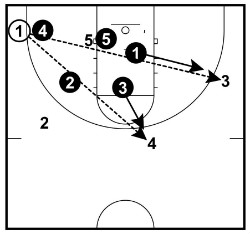 The basketball will be covered by the weak-side wing player if the ball is skipped to either the opposite wing or corner.
The basketball will be covered by the weak-side wing player if the ball is skipped to either the opposite wing or corner.
Same as the wing to corner pass, if the basketball is skipped corner to corner, the weak-side wing closes out on the high side to prevent the reversal pass and is then bumped up away by the recovering post player.
Top to Corner Skip Pass
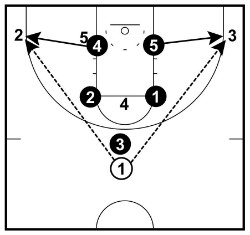 When the basketball is passed from the top to the corner, the post player must sprint out to contest the outside shot and play defense.
When the basketball is passed from the top to the corner, the post player must sprint out to contest the outside shot and play defense.
It’s imperative that the post players are always fighting for top position so that they have a clear run to the corner.
If the opposition is smart and has good shooters, they’ll try to screen the bottom player as the skip pass is being thrown.
Variations
Variation 1 – Two Stay Inside
‘Two Stay Inside’ is a great variation of the 1-2-2 zone defense that will suit your team if;
1. The opposition aren’t good three-point shooters.
2. You have two big men you want to keep on the inside.
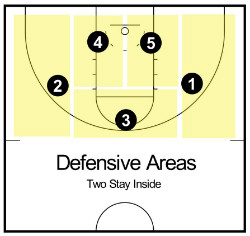 Basically, instead of all 5 defenders guarding the perimeter like in the traditional 1-2-2 zone defense, this variation allows you to keep your two biggest players next to the basket and uses the two wing players to guard the corners as well.
Basically, instead of all 5 defenders guarding the perimeter like in the traditional 1-2-2 zone defense, this variation allows you to keep your two biggest players next to the basket and uses the two wing players to guard the corners as well.
This will lead to a lot of scrambling by the wing defenders and will give up more open outside shots, but this won’t matter if you’re playing against a weak outside shooting team.
Conversely, if the opposition can knock down the corner three-pointer consistently, you won’t be able to stay in this zone.
How it Works:
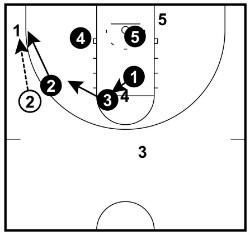 On a pass to the corner, instead of the post player closing out on the corner player, the wing player is required to scramble and close out on the basketball.
On a pass to the corner, instead of the post player closing out on the corner player, the wing player is required to scramble and close out on the basketball.
This isn’t an ideal rotation, but remember, we’re only using this variation against teams that aren’t great from the perimeter.
In fact, sometimes it’s not a bad thing to tempt bad shooting teams with open shots!
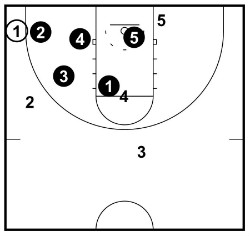 The other two perimeter defenders rotate around on this pass so that someone is always covering the high post.
The other two perimeter defenders rotate around on this pass so that someone is always covering the high post.
Using this variation also means that your post players will never be required to front the post. They should always play behind and be close to the ring.
While this isn’t a perfect defense, this variation lets you get to keep your two strong post players protecting the key and the basket and is great against teams that can’t shoot well.
Variation 2 – Point Drop Zone
I’ll only go over the point drop zone variation quickly as it deserves its own entire post.
The ‘Point Drop’ zone (also known as the sliding zone) is best used when you have a big, athletic, stand-out defensive player that you want to always keep between the basketball and the ring.
This player will be the top defender.
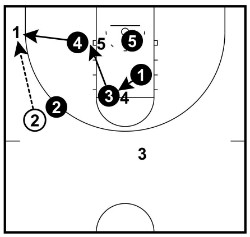 The variation is played the same when the basketball is at the top of the key and on the wings, but changes dramatically when the basketball is passed to the corners.
The variation is played the same when the basketball is at the top of the key and on the wings, but changes dramatically when the basketball is passed to the corners.
The big difference is that when the basketball is passed to the corner, the top defender will immediately slide down and front the post. This does a few things…
1. It keeps your best, athletic defender between the basketball and the ring.
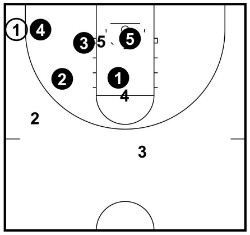 2. It allows your team to front the post when the basketball is in the corner.
2. It allows your team to front the post when the basketball is in the corner.
3. There will always be one of your post players on split line instead of the weak-side wing.
This continues regardless of which side the basketball is on. When the basketball is in the corner, it’s the top defender that fronts the post.
It now becomes the responsibility of the weak-side wing player to deny the high post since the top defender is near the low block.
Conclusion
The 1-2-2 zone defense is a great zone to use against teams that can shoot the basketball at a high rate. By using all 5 players to guard the perimeter, your team won’t give up many open three-point shots.
I often recommend this zone option to coaches that have a dominant, athletic player to put at the top defender position.
If you that sounds like your team, this could be a great zone for you to implement.
